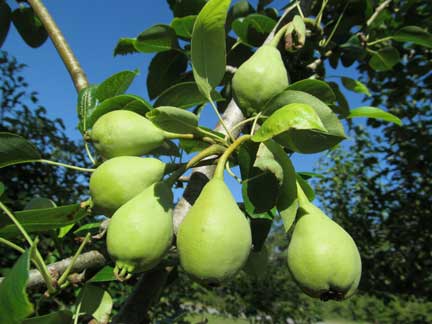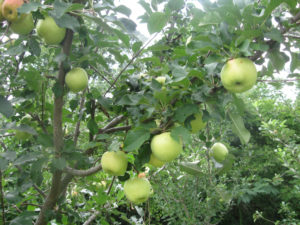 Everyone wants to have the largest sized fruit they can grow. Beyond good watering and regular fertilizing, one of the best-kept secrets to obtaining maximum fruit size is to thin the fruit load on your trees. Thinning is the act of removing part of the crop to allow the tree to maximize the size of the remaining fruit. It not only ensures you have large fruit at harvest, it also ensures that the tree is not weakened by an excessive fruit load. Allowing some types of fruit trees to bear as much as they want to can lead to problems like alternate bearing; this is a cycle where the tree bears a heavy crop one year, followed by little or no fruit the next year. Heavy fruit loads can also weaken the tree, leaving it open to insect and diseases, and shortening its life. The weight of a heavy fruit load can distort the shape of the tree, as well as cause limb breakage. Tightly clustered fruits are also more subject to fruit rot problems.
Everyone wants to have the largest sized fruit they can grow. Beyond good watering and regular fertilizing, one of the best-kept secrets to obtaining maximum fruit size is to thin the fruit load on your trees. Thinning is the act of removing part of the crop to allow the tree to maximize the size of the remaining fruit. It not only ensures you have large fruit at harvest, it also ensures that the tree is not weakened by an excessive fruit load. Allowing some types of fruit trees to bear as much as they want to can lead to problems like alternate bearing; this is a cycle where the tree bears a heavy crop one year, followed by little or no fruit the next year. Heavy fruit loads can also weaken the tree, leaving it open to insect and diseases, and shortening its life. The weight of a heavy fruit load can distort the shape of the tree, as well as cause limb breakage. Tightly clustered fruits are also more subject to fruit rot problems.
WHAT FRUIT TREES NEED THINNING
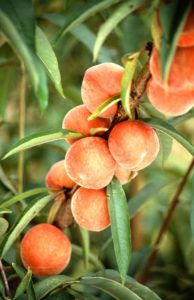 A lot of fruit trees will self-regulate their fruit loads, without any help from you. Â Figs, blueberries, pomegranate, citrus and nut trees are all fruits that do not require thinning. The ones that need assistance are apples, pears, peaches, plums, nectarines. This group will require yearly thinning throughout their lives. Fruits like persimmons are prone to regulate well on most years, but occasionally set a bumper crop, and on those years it best to remove part of the crop. Some of the vining type fruits, like kiwi and bunch grapes, benefit from the removal of some of the clusters to keep the vines healthy.
A lot of fruit trees will self-regulate their fruit loads, without any help from you. Â Figs, blueberries, pomegranate, citrus and nut trees are all fruits that do not require thinning. The ones that need assistance are apples, pears, peaches, plums, nectarines. This group will require yearly thinning throughout their lives. Fruits like persimmons are prone to regulate well on most years, but occasionally set a bumper crop, and on those years it best to remove part of the crop. Some of the vining type fruits, like kiwi and bunch grapes, benefit from the removal of some of the clusters to keep the vines healthy.
TIMING ON THINNING THE CROP
The timing of when to thin your crop load is key to keeping the fruit crop from weakening the tree. You want to wait until the tree goes through its natural fruit drop before doing the thinning. Often right after blossoming some flowers not properly pollinated will turn yellow and drop, after the tree sets the crop and it is still small the tree goes through a natural fruit drop as it self- regulates itself for what it thinks is the necessary fruit load. It is right after this that you’ll want to do your hand thinning. For kiwi, apples, and pears you’ll wait until the fruit is ½ to 1 inch in size. For peaches, plum and nectarines wait until the fruit is ¾ to 1 inch. For persimmons wait until the fruit is 1-2 inches. For bunch grapes thin the clusters when the berries are 1/8 to ¼ inch in size.
HOW MUCH FRUIT THIN THIN OFF
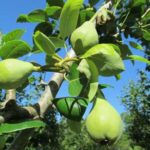
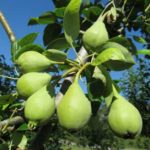
How much fruit to thin depends on the type of fruit and the health of the tree. Fruits that are naturally small like kiwi and plums should be thinned to where they are 2 to 4 inches apart on the branch. Peaches and nectarines need to be thinned to about 3-5 inches apart. Cluster fruits like apple and pears, simply break the cluster to where there is only 1 or 2 fruit per cluster. Bunch grapes are thinned to where they are 4-6 inches apart on the branch. All through the life of the tree be aware of the general health of the tree. If the tree is struggling from lack of water and nutrition, take more fruit off, or in the case of a very sick tree take all of the fruit off. This year off will allow the tree to recover and build its health to fruit well into the future.
BEST METHODS TO THIN YOUR FRUIT TREES
 There are basically two methods to thin your fruit trees. Thinning by hand ensures the fruit is well spaced but it does take a lot of time. Thinning by the pole method is faster but less accurate. Hand Thinning requires removing enough fruit so that they do not touch. This can be done by just pulling off or cutting the fruit off with your pruning shears. A small pair of thin pointed shears works well for this job. Try to remove clusters of fruit to where there is just 1-2 fruit remaining. On long branches that have fruit the entire length, try to remove fruit from the terminal end to lessen the weight on the branch and thin the remaining fruit on the lower end of the branch to their respective distances listed above. When choosing which fruit to remove try to take the diseased, disfigured and small fruit. Pole Thinning is best used on large branches that are not easy to reach. It involves using a stick or thin pole that has the end padded with a rubber hose or soft cloth to prevent the injury to the branch when tapping. With a little practice, you will get good at tapping the clusters to dislodge the fruit and break up the clusters.
There are basically two methods to thin your fruit trees. Thinning by hand ensures the fruit is well spaced but it does take a lot of time. Thinning by the pole method is faster but less accurate. Hand Thinning requires removing enough fruit so that they do not touch. This can be done by just pulling off or cutting the fruit off with your pruning shears. A small pair of thin pointed shears works well for this job. Try to remove clusters of fruit to where there is just 1-2 fruit remaining. On long branches that have fruit the entire length, try to remove fruit from the terminal end to lessen the weight on the branch and thin the remaining fruit on the lower end of the branch to their respective distances listed above. When choosing which fruit to remove try to take the diseased, disfigured and small fruit. Pole Thinning is best used on large branches that are not easy to reach. It involves using a stick or thin pole that has the end padded with a rubber hose or soft cloth to prevent the injury to the branch when tapping. With a little practice, you will get good at tapping the clusters to dislodge the fruit and break up the clusters.

